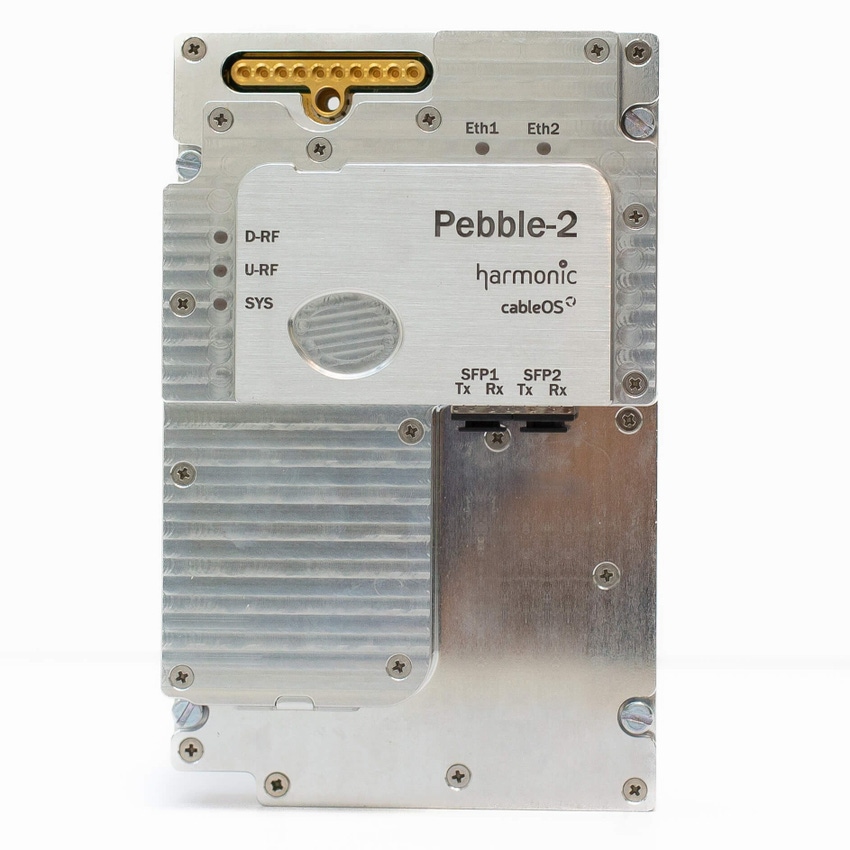Harmonic goes network-agnostic with 'Pebble-2' module
Harmonic's new remote device for distributed access networks is designed to support remote PHY, remote MACPHY along with PON and DOCSIS 4.0 access networks.

Harmonic is taking the network-agnostic angle with a new remote distributed access architecture (DAA) module that's built to work with a wide range of both hybrid fiber/coax (HFC) and fiber-based access networks.
While Harmonic's original Pebble module for network nodes supports only the remote PHY flavor of DAA, its new Pebble-2 still supports remote PHY along with a pathway to remote MACPHY. Remote PHY places the PHY elements of the network toward the edge and keeps the MAC processing centralized. Remote MACPHY places both the MAC and the PHY at the edge.
Pebble-2 is also equipped to support DOCSIS 4.0, which requires DAA, and can be equipped to support PON-based fiber-to-the-premises (FTTP) networks as well.
With respect to DOCSIS 4.0, Harmonic says its approach can support both flavors of the specs – Full Duplex DOCSIS (FDX) and Frequency Division Duplexing (FDD). FDX, a version largely championed by Comcast, envisions a DOCSIS 4.0 network built to 1.2GHz with an FDX band that allows for upstream and downstream spectrum to occupy the same block of spectrum. FDD envisions an HFC network built to 1.8GHz while keeping upstream and downstream operating in separate, dedicated spectrum.
Figure 1:  Harmonic says its new Pebble-2 module for network nodes is designed to support multiple approaches to DAA alongside PON networks and future DOCSIS 4.0 networks.
Harmonic says its new Pebble-2 module for network nodes is designed to support multiple approaches to DAA alongside PON networks and future DOCSIS 4.0 networks.
(Source: Harmonic)
Harmonic, a supplier that grapples with competitors such as CommScope, Casa Systems and Vecima Networks, notes that the new module, introduced in tandem with this week's SCTE Cable-Tec Expo in Philadelphia, also works with the CableLabs Flexible MAC Architecture (FMA), an approach that enables MAC processing to be located centrally or at the edge. Harmonic is targeting that with its relatively new "MAC Anywhere" architecture.
The Pebble-2 is modular in that it can support that range of use cases via the same form factor and basic hardware, according to Daniel Etman, the exec heading up marketing for Harmonic's broadband division.
Can be adapted to third-party nodes
In addition to snapping into Harmonic's own Ripple nodes, the Pebble-2 can also be adapted to third-party nodes, including Cisco's GS7000 node. Cisco's GS7000 nodes are approaching end-of-life – end-of-sale on the product is set for November 11, 2022, and the last ship date is slated for February 9, 2023.
Pebble-2 will initially support remote PHY as it hits the market in the fourth quarter of 2022, and then follow with support for the other use cases, Etman said, noting that trials of Pebble-2 are now underway.
Harmonic hasn't revealed who is already on board with Pebble-2. However, Justin Colwell, Charter Communications' EVP of connectivity technology, gave Harmonic's DAA-based products a plug in today's announcement.
Fits with DAA and the shift to virtualized networks
And like the original Pebble, Pebble-2 also works in tandem with CableOS, Harmonic's software-based network virtualization platform. Comcast is the marquee customer for CableOS. Others operators on board include Rogers Communications, Vodafone and GCI, among dozens more. Harmonic says CableOS currently supports more than 10 million cable modems worldwide.
Harmonic's new offering and agnostic angle arrives as cable operators start to determine their next big moves on the access network. While many are using enhanced versions of DOCSIS 3.1 that beef up the upstream with "mid-split" or "high-split" upgrades that dedicate more spectrum to the upstream path, others are starting to prep legacy HFC for DOCSIS 4.0 along with FTTP builds targeted to greenfields. Still others are pursuing FTTP upgrades/overbuilds that will skip D4.0 all together.
With that in mind, Etman said there's a "sense of urgency" tied to the DAA transition as integrated converged cable access platforms (CCAPs) start to reach the end of the line and operators look for ways to upgrade their access networks while also cutting down on power and space requirements.
Related posts:
— Jeff Baumgartner, Senior Editor, Light Reading
Read more about:
EuropeAbout the Author(s)
You May Also Like











